Table of Contents
ELECTRIFIED BEN
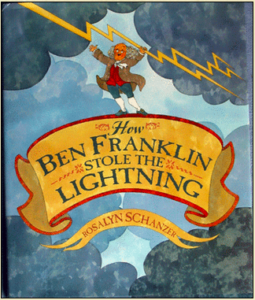
|
Rosalyn Schanzer’s How Ben Franklin Stole the Lightning (HarperCollins, 2002) is a folksy picture-book account of Franklin’s inventions and scientific experiments, with special attention to his studies of electricity, including the famous kite-in-the-storm experiment and Franklin’s promotion of the lightning rod. For ages 6-11. |
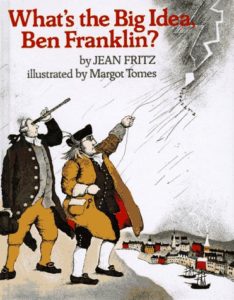
|
Jean Fritz’s What’s the Big Idea, Ben Franklin? (Perfection Learning, 2001) is a witty and interesting biography of Franklin, filled with human interest, and emphasizing his many ideas and innovations, among them his electrical experiments. Don’t be deceived by the ugly cover. For ages 7-10. |
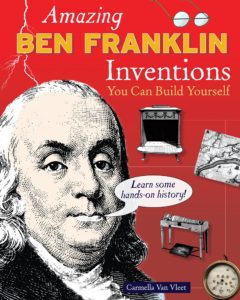
|
Carmela Van Vleet’s Amazing Ben Franklin Inventions You Can Build Yourself (Nomad Press, 2007) has both biographical background information and instructions for 30 different hands-on activities based on Franklin’s many varied interests. In the “Electricity and the Lightning Rod” chapter, for example, kids make a potato battery and a kite. For ages 9-12. |
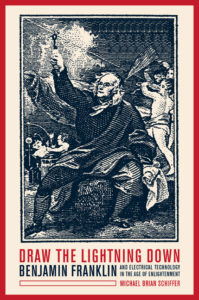
|
Michael Brian Schiffer’s nearly 400-page Draw the Lightning Down: Benjamin Franklin and Electrical Technology in the Age of Enlightenment (University of California Press, 2006) is a well-researched history of Franklin’s electrical experiments and his essential role in the history of electrical technology. For older teenagers and adults. |
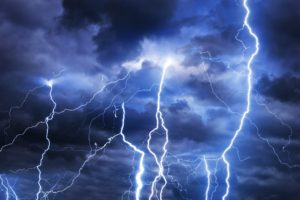 |
Learn all about lightning from NASA’s Lightning Primer. |
| From the Franklin Institute, see Ben Franklin and the Kite Experiment. (Don’t ever try this at home!) | |
| For more Franklin resources, see Ben Franklin. | |
| Also see Clouds, Rain, and Storms. |
LIGHTS!
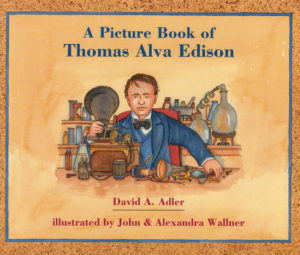
|
David A. Adler’s A Picture Book of Thomas Alva Edison (Holiday House, 1999) is a short simple biography of the inventor for ages 4-8. |
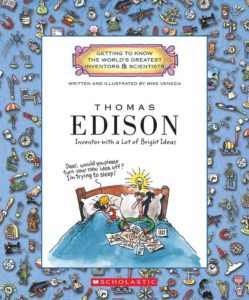
|
Mike Venezia’s Thomas Edison: An Inventor With a Lot of Bright Ideas (Children’s Press, 2009) is an entertaining biography in the “Getting to Know the World’s Greatest Inventors and Scientists” series, illustrated with photos and clever cartoons. For ages 5-9. |
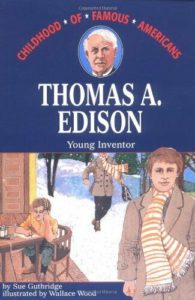
|
In the Childhood of Famous Americans series, Sue Guthridge’s fictionalized Thomas Edison: Young Inventor (Aladdin, 1986) concentrates on Edison’s childhood, including his deafness (which led his mother to homeschool him), his home experiments, and the “laboratory on wheels” that he set up in an empty box car while working on a train. (It exploded.) For ages 7-11. |
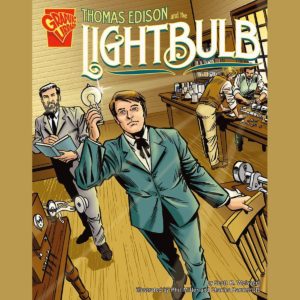
|
Scott Welvaert’s Thomas Edison and the Lightbulb (Capstone Press, 2007) is a catchy graphic-novel-style biography of Edison’s race to develop an effective incandescent lightbulb, with appended book and resource lists. This is one of a series; other titles include The Wright Brothers and the Airplane, Philo Farnsworth and the Television, Marie Curie and Radioactivity, and Isaac Newton and the Laws of Motion. (For a complete list, see Capstone Press.) For ages 8 and up. |
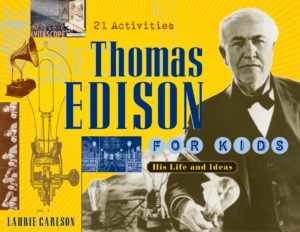
|
Laurie Carlson’s Thomas Edison for Kids (Chicago Review Press, 2006) is a comprehensive biography of Edison, illustrated with photographs, period prints, and diagrams, and including 21 hands-on activities, among them making an electrical switch, a telegraph, and a zoetrope. For ages 9-12. |
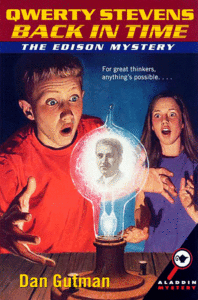
|
Dan Gutman’s Back in Time with Thomas Edison (Simon & Schuster Books for Young Readers, 2002) stars thirteen-year-old Qwerty Stevens (his nickname comes from a third-grade typing goof) who digs up a mysterious device in his backyard that sends him and his sister back to Thomas Edison’s laboratory in the late 19th century. Along with the exciting time-travel story, the book provides information about Edison’s life and work. Included are period photos and patent drawings, and an Edison timeline. For ages 9-12.
Also see Back in Time with Benjamin Franklin (2005). |
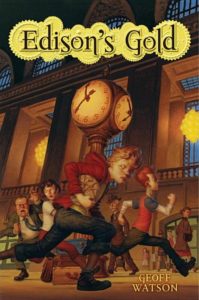
|
In Geoff Watson’s Edison’s Gold (Egmont USA, 2010), seventh-grader Thomas Edison IV, great-great-grandson of the famous inventor, believes he may have found clues leading to his ancestor’s secret formula for changing base metal into gold – but he and his sidekicks have competition in their quest, primarily in the form of a descendant of Nikola Tesla, Edison’s arch-enemy. A mystery/thriller for ages 9-13. |
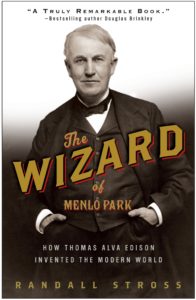 |
Randall E. Stross’s The Wizard of Menlo Park(Broadway, 2008) is a fascinating biography of Thomas Edison (“the patron saint of electric light”), his many inventions, and his overwhelming public persona. For teens and adults. |
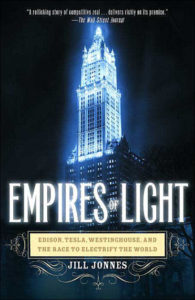
|
Jill Jonnes’s Empires of Light (Random House, 2004) details the 19th-century battle among Thomas Edison, Nikola Tesla, and George Westinghouse to forge an electrical empire, including the “War of the Electric Currents” between the supporters of AC current (Westinghouse and Tesla) and DC current (Edison and followers). For teens and adults. |
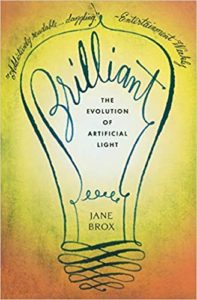 |
Jane Brox’s Brilliant (Mariner Books, 2011) is a history of artificial light, from the torches of the Stone Age to the light bulb to the sometimes overwhelming illumination of the modern day. For teens and adults. |
| Build your own light bulb! With adult supervision. | |
| Build a cool Lego lightbulb! | |
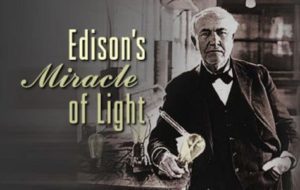 |
See Edison’s Miracle of Light, a film in the PBS American Experience series, and accompanying resources. |
| Thomas Edison for Kids from the National Park Service has period photos, an Edison biography and timeline, info on Edison’s inventions, and more. | |
| See here to listen to early Edison sound recordings – including a really creepy talking doll – and try and Edison employment test. | |
| At the Franklin Institute, see (and learn all about) Edison’s Lightbulb. | |
| AC/DC: What’s the Difference? is a nicely designed animation on direct and alternating currents. | |
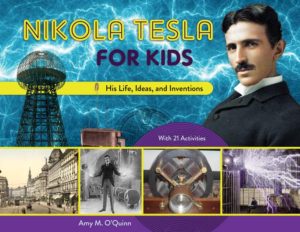 |
Amy M. O’Quinn’s Nikola Tesla for Kids (Chicago Review Press, 2019) covers the Tesla’s life and inventions, with 21 hands-on projects and activities, among them building an electric circuit and a soda-bottle submarine, making a batch of fluorescent slime, and taking a virtual tour of the 1893 Chicago World’s Fair. Includes maps, period photos, diagrams, and a timeline. For ages 9 and up. |
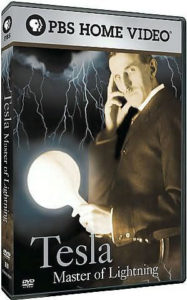 |
From PBS, Tesla: Master of Lightning has information on Nikola Tesla’s life and work, interactive explorations of Tesla’s inventions, a tutorial on electricity, timelines, and lesson plans on energy and electricity. |
| Take a virtual tour of the Nikola Tesla Museum in Belgrade. |
